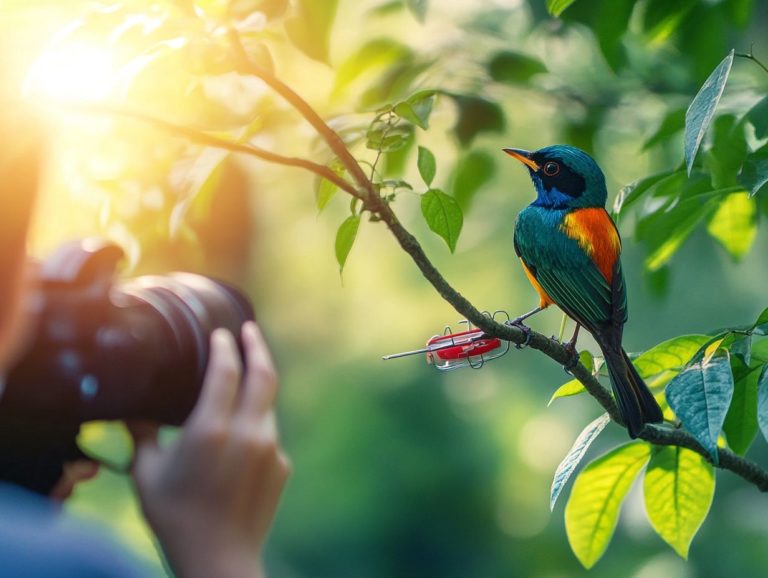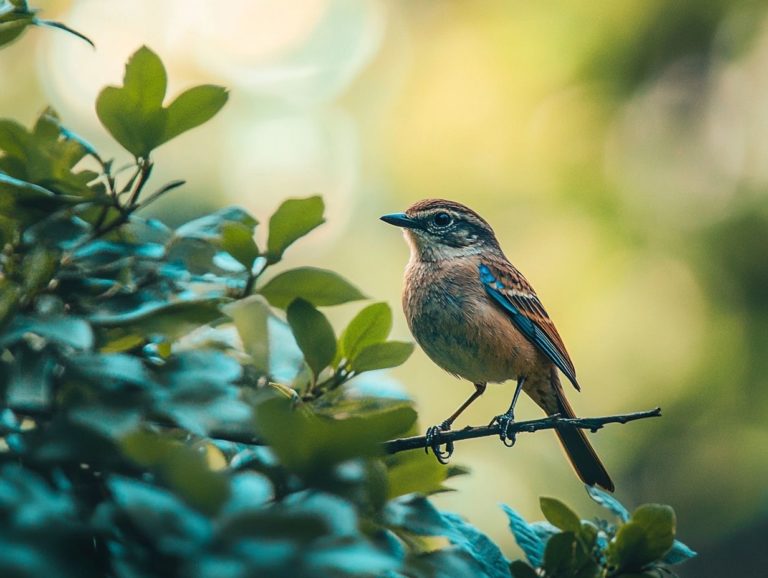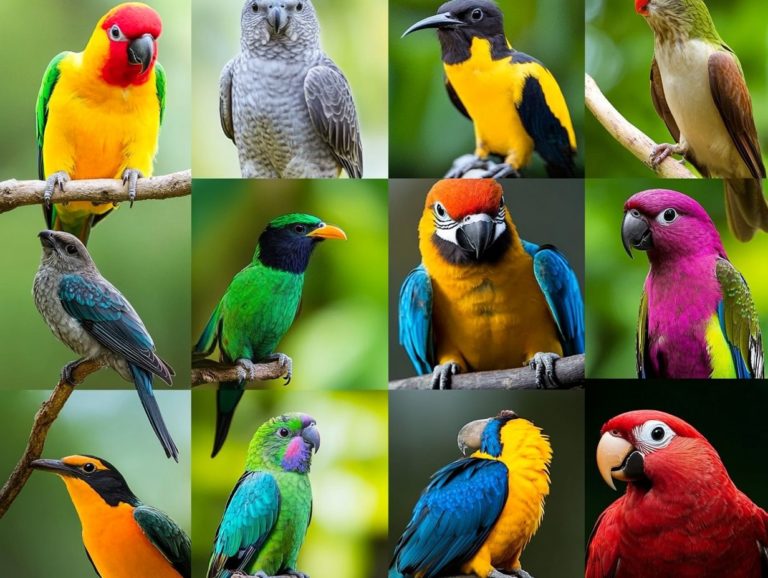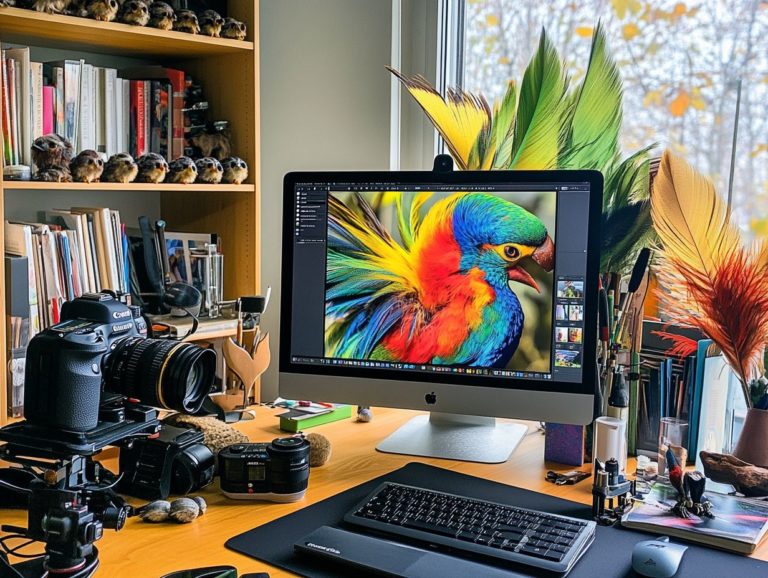How to Choose the Right Flash for Birds
Capturing stunning images of birds in their natural habitat is a rewarding yet challenging endeavor.
One crucial element in achieving breathtaking shots is selecting the right flash. The type of flash you choose significantly impacts the clarity and brilliance of your photographs and can even influence bird behavior.
In this exploration, you’ll delve into the various types of flash units external and built-in while considering important factors that will guide your decision-making. You ll also discover essential tips for effective use and explore alternatives to flash photography.
Whether you’re a seasoned photography enthusiast or just beginning your journey, understanding these aspects will enhance your bird photography experience and elevate your results.
Contents
- Key Takeaways:
- The Importance of Choosing the Right Flash for Birds
- Types of Flashes for Bird Photography
- Factors to Consider When Choosing a Flash
- Frequently Asked Questions
- What factors should I consider when choosing a flash for bird photography?
- What is the ideal flash power for photographing birds?
- Can I use any type of flash for bird photography?
- What is flash duration and why is it important for bird photography?
- Should I opt for a manual or TTL flash for bird photography?
- Are there any additional features I should look for in a flash for bird photography?
Key Takeaways:

- Choose a flash specifically designed for bird photography to minimize disturbance and capture high-quality photos, particularly when photographing Coal Tits.
- Consider factors such as power, range, compatibility, and additional features when selecting a flash for your camera and lens.
- Proper positioning and settings are crucial when using a flash for bird photography. You can also use natural light and reflectors instead of a flash.
The Importance of Choosing the Right Flash for Birds
Choosing the right flash for bird photography is essential for capturing stunning images that showcase both the beauty and behavior of birds, like those charming Coal Tits in the Northern Hemisphere. An appropriate flash setup can greatly enhance the quality of your photographs.
Whether you’re working in natural light or incorporating additional lighting techniques, the right flash can transform your images.
When used right, your flash can aid in monitoring bird populations and contribute to environmental health assessments. This aligns perfectly with the mission of organizations like the Audubon Society, dedicated to safeguarding these wildlife species through various scientific projects.
The right flash not only illuminates vibrant colors but also brings out intricate details in your subjects. This results in captivating silhouette photography and strikingly detailed shots.
Impact on Bird Behavior and Photos
Using flash can dramatically change how birds behave! Understanding how artificial light affects avian species is essential.
Flash can induce stress or lead to avoidance behaviors in sensitive birds, potentially altering their feeding patterns and nesting habits. This makes it imperative for photographers like you to approach your subjects with care.
By employing techniques such as using a diffuser a device that softens the light or opting for low-intensity flashes, you can significantly minimize disturbances. This not only fosters a more ethical and less intrusive experience but also enhances your chances of capturing stunning images.
Wildlife photography that embraces these strategies often showcases birds in their natural state, unhindered by the stress that harsh lighting can impose.
Types of Flashes for Bird Photography
In bird photography, it s crucial for you to grasp the nuances between various types of flashes like external and built-in units to truly elevate your results. This knowledge empowers you to capture stunning wildlife moments!
Understanding these differences will help you capture the breathtaking beauty of wildlife in motion, particularly during extraordinary moments, such as birds soaring against a snowy backdrop or playfully visiting feeders.
External vs Built-In Flashes
External flashes offer remarkable versatility in bird photography that built-in flashes simply can t match. They give you greater control over light direction and intensity essential when trying to capture fast-moving subjects like hummingbirds in Ecuador or Coal Tits in the Northern Hemisphere.
This flexibility is crucial, particularly since the unique behaviors of these birds often demand that you adapt to ever-changing lighting conditions. While built-in flashes are convenient, they typically lack the power and range needed to illuminate distant subjects or create dramatic lighting effects that can bring your photos to life.
Take, for example, an external flash like the Canon Speedlite 600EX II-RT. It offers high output and allows for techniques such as bounce flash, which softens shadows and enhances a more natural look. On the other hand, Nikon s SB-5000 comes equipped with advanced wireless capabilities, enabling you to sync multiple flashes for intricate lighting setups.
With this flexibility, you can brilliantly capture vibrant colors and intricate details, whether you’re navigating the dense rainforests or working in open fields. Each environment presents its own unique lighting challenges, especially for obtaining micro-contrast.
Factors to Consider When Choosing a Flash

When selecting a flash for bird photography, you must consider several key factors, such as power, range, and compatibility with your camera and lens. These elements are essential for achieving the best results in diverse lighting conditions, whether you re shooting in the bright daylight of Europe or the enchanting dusk of America.
Power and Range
Power and range are essential elements in flash photography, especially when you’re out in the wild capturing those breathtaking moments. A higher power output gives you the coverage you need, particularly when you’re photographing birds in flight or facing tricky lighting conditions.
This knowledge is also important in event photography. Imagine a wedding reception where your subjects are scattered across a vast area. A flash with robust power can illuminate distant groups without sacrificing exposure quality, ensuring that every precious moment is captured with clarity.
On the flip side, a flash with limited range can leave sections underexposed, which detracts from the overall beauty of your composition. This balance between power and range is also crucial in portrait photography. It grants you greater control over exposure, allowing you to create stunningly lit portraits even in dim settings, showcasing your subject’s features to perfection.
Compatibility with Camera and Lens
Ensuring compatibility between your flash and camera or lens is crucial in bird photography for achieving the best results. This is especially true when you re employing advanced techniques like high-speed sync (which allows you to capture fast-moving subjects without blur) or TTL (Through The Lens) metering, found in models like the Nikon D500.
It s easy to overlook the unique quirks of specific camera brands and models, but doing so can lead to frustrating results and missed opportunities. Different lens types also play a significant role in how your flash performs. For example, wide-angle lenses require careful attention to light distribution to prevent hotspotting, while telephoto lenses may need different flash power settings to effectively capture distant subjects.
Ignoring compatibility issues can result in common pitfalls such as underexposed images, erratic lighting, or even the flash completely failing to fire. That s why diving into the specifications of both your camera and lens is essential; thorough research sets the stage for a successful and enjoyable shooting experience.
Additional Features for Bird Photography
Additional features in flashes can significantly elevate your bird photography. They allow you to harness advanced technology to capture stunning images of wildlife, regardless of distance or lighting conditions, especially when using battery packs and off-shoe cords.
High-speed sync is essential when photographing birds in flight. It enables you to freeze action without compromising exposure. This is a game-changer on bright, sunny days, as it permits a wider aperture, creating beautiful bokeh effects while keeping the bird in sharp focus.
TTL (Through The Lens) functionality simplifies the process of automatically adjusting flash output, which is invaluable when faced with unpredictable lighting changes in natural environments. With precise control over flash output, you can achieve a harmonious balance between ambient light and flash. This results in richer colors and dynamic compositions that truly highlight the beauty of your avian subjects.
Tips for Using a Flash in Bird Photography
To truly harness the advantages of using flash in bird photography, it s vital to employ strategic techniques, such as optimal positioning and precise camera settings. By doing so, you ll effectively capture amazing photos of wildlife, including the dazzling beauty of hummingbirds in their natural environments.
Proper Positioning and Settings

Properly positioning your flash is crucial. Adjusting your camera settings like ISO, shutter speed, and aperture also matters for elevating your bird photography experience.
To maximize the effectiveness of the flash, angle it slightly away from your subject. This simple adjustment minimizes direct glare, preventing harsh shadows and preserving vibrant colors. Incorporating a softbox or diffuser can enhance your lighting, providing even illumination that flatters your feathered subjects.
Tweaking the ISO can boost your camera’s sensitivity to light, while the shutter speed plays a crucial role in capturing motion, especially with a bird in flight. Setting the right aperture is vital; it allows you to control the depth of field. This ensures your subject stands out in sharp focus against a beautifully blurred background, enhancing your composition and capturing bright colors in wildlife photography.
Minimizing Disturbance to Birds and Alternatives to Using a Flash
Minimizing disturbance to birds while using flash in photography is essential for ethical wildlife practices. This ensures that the natural behaviors of species like Coal Tits, hummingbirds, and other birds are respected, particularly in their habitats across Europe and America.
Aim to use flash discreetly by exploring alternative methods, such as fill flash. This technique improves exposure without overwhelming your subject, enhancing details in shadows while preserving the soft ambiance of natural light.
Understanding and respecting animal behavior is crucial. Be patient and observant, allowing wildlife to go about their activities undisturbed. By choosing softer lighting approaches and maintaining a respectful distance, you can create stunning images that capture the essence of wildlife without interfering with their daily lives.
Exploring alternatives to using flash can unlock new possibilities for capturing breathtaking images. Leverage natural light or utilize reflectors to enhance lighting and elevate your work to a whole new level.
Time is of the essence when capturing fleeting moments in wildlife photography. Adjust your settings quickly to seize the perfect shot!
Now, grab your camera and get ready to capture the breathtaking beauty of birds in action!
Natural Light and Reflectors
Natural light, paired with strategic use of reflectors, offers an excellent alternative to flash photography. This method allows you to capture the essence of your bird subjects in a more organic and authentic setting.
To effectively use natural light, understand how it changes throughout the day. In the soft, golden hues of early morning, the light provides a warm touch to your images. However, the harsh midday sun can cast unflattering shadows that detract from the subject’s beauty.
Use reflectors to direct light onto your feathered subjects. This technique softens shadows and enhances their vibrant colors. For example, during late afternoon, as the sun begins to set, reflectors can create a gentle glow, making the birds stand out against their surroundings.
Experiment with different angles of reflectors to capture stunning highlights in plumage. This will help you utilize techniques learned in photography workshops.
Frequently Asked Questions
What factors should I consider when choosing a flash for bird photography?
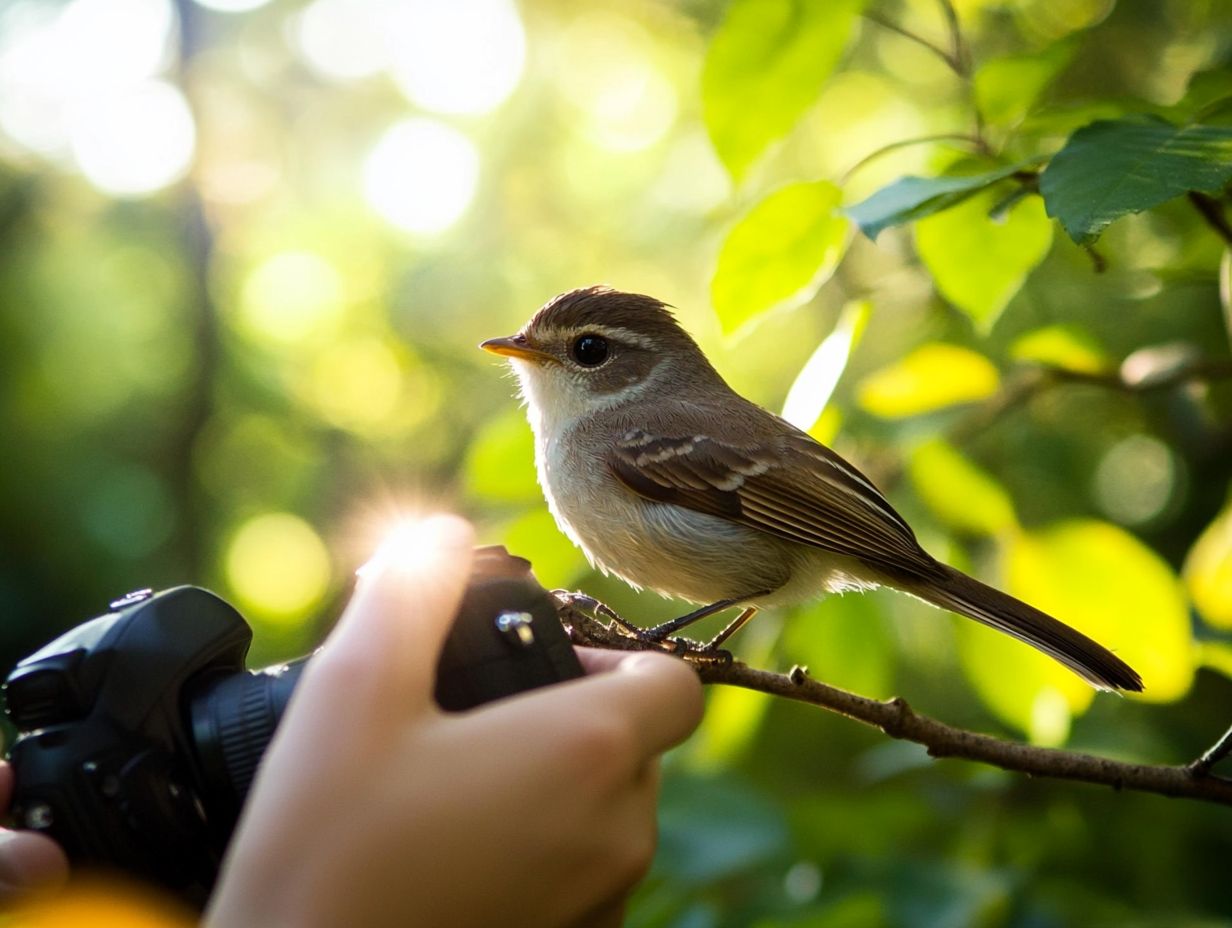
When choosing a flash for bird photography, consider factors like flash power, camera compatibility, the duration of the flash, and ease of use. This is particularly important for models like the V860II or Godox flashes.
What is the ideal flash power for photographing birds?
The ideal flash power depends on the type of bird and how far away you are from the subject. Generally, a flash with a power rating of at least 60 is recommended for outdoor bird photography.
Can I use any type of flash for bird photography?
While technically you can use any flash, it’s best to select one designed for outdoor use. This choice ensures that the flash can handle the elements and provide the necessary power for capturing fast-moving birds. Understanding exposure for bird photography will also enhance your results.
What is flash duration and why is it important for bird photography?
Flash duration is the length of time the flash fires. A shorter flash duration is preferred for bird photography, as it helps to freeze the birds’ movements and capture sharp, detailed images.
Should I opt for a manual or TTL flash for bird photography?
Both manual and TTL (Through-The-Lens) flashes can be effective for bird photography. However, TTL flashes are generally recommended, as they automatically adjust the flash power based on your camera settings, making it easier to take well-exposed images.
Are there any additional features I should look for in a flash for bird photography?
When choosing a flash, consider features like high-speed sync, wireless capabilities, and a rotatable head for versatile lighting angles. These features can greatly enhance your bird photography experience.


